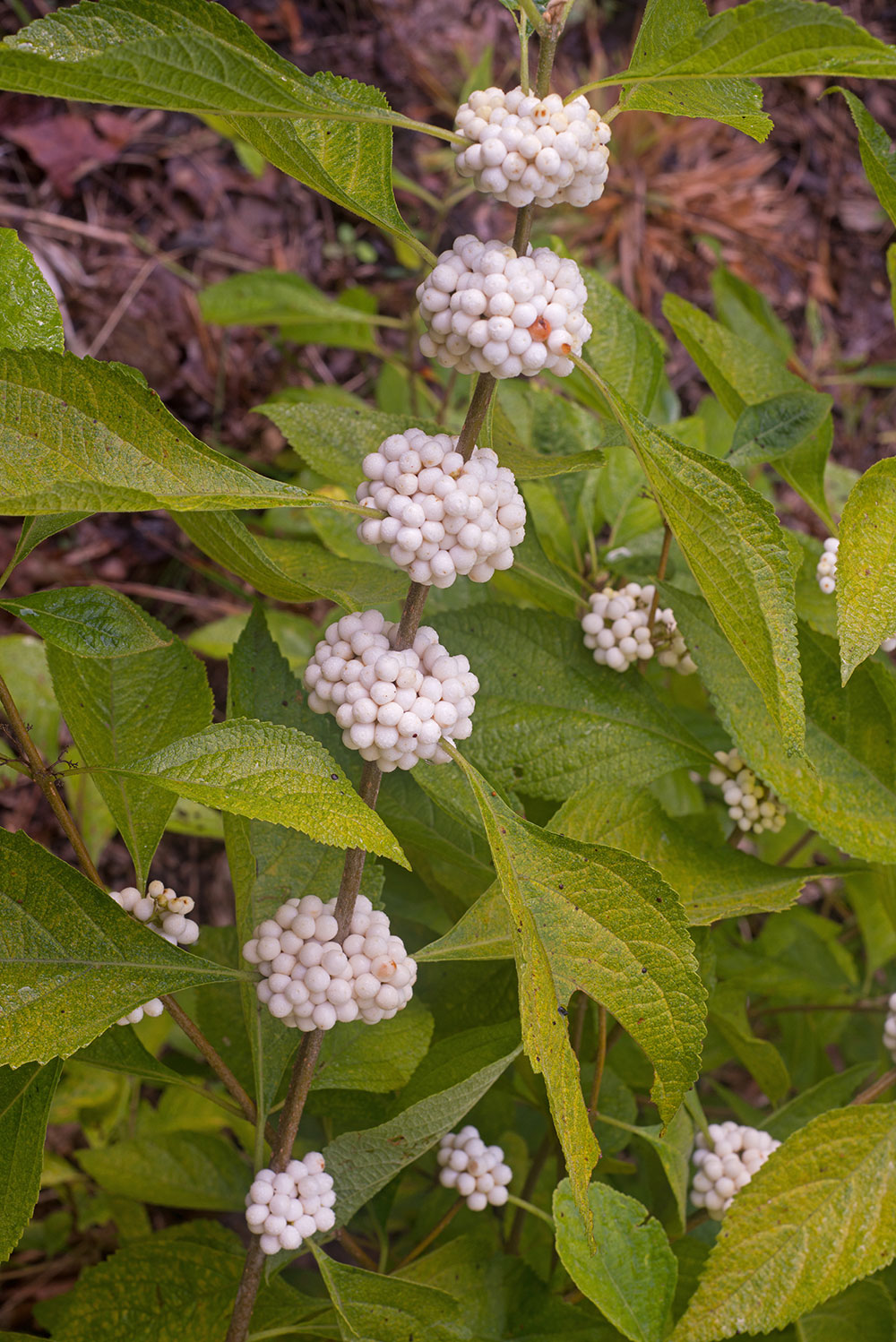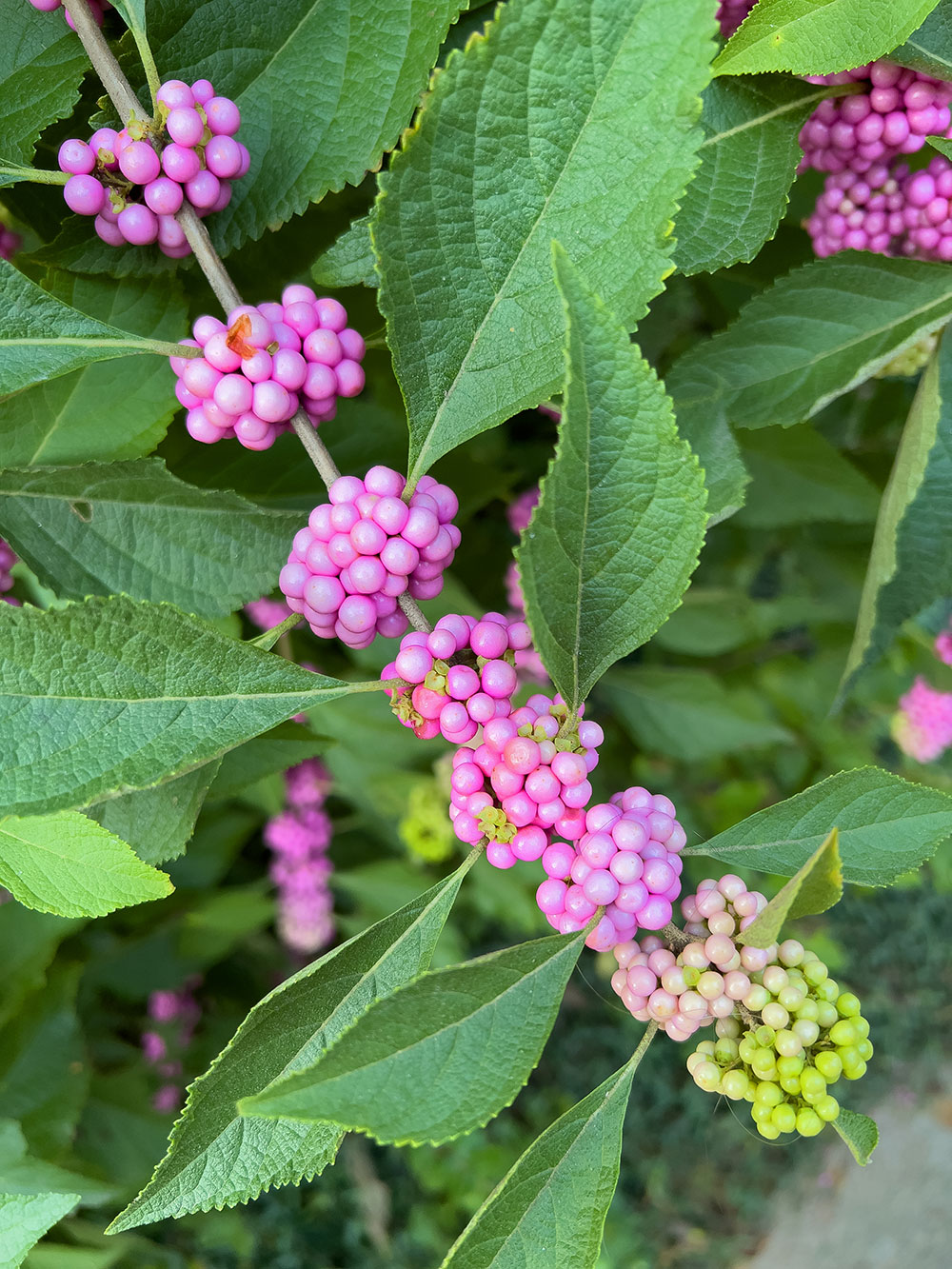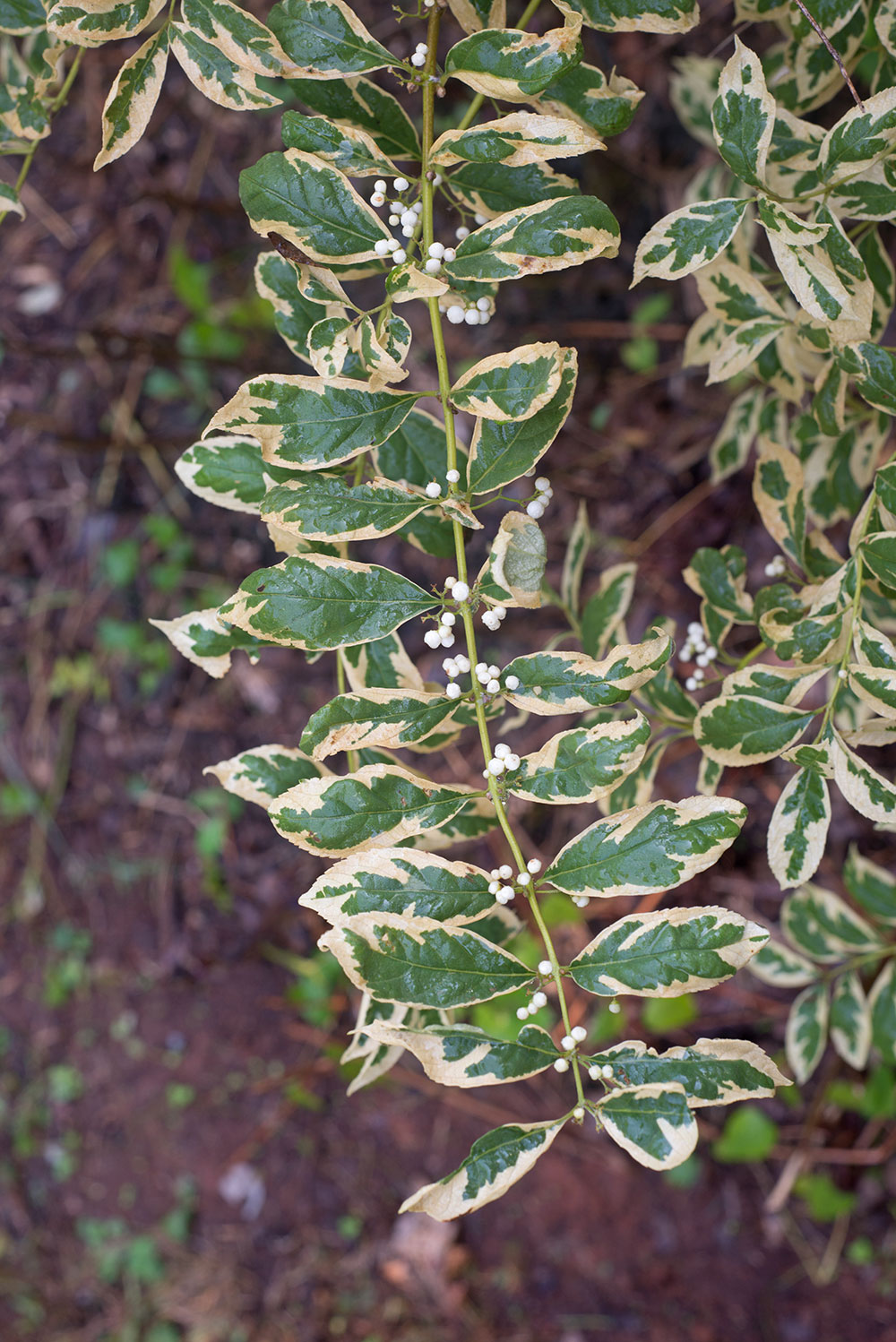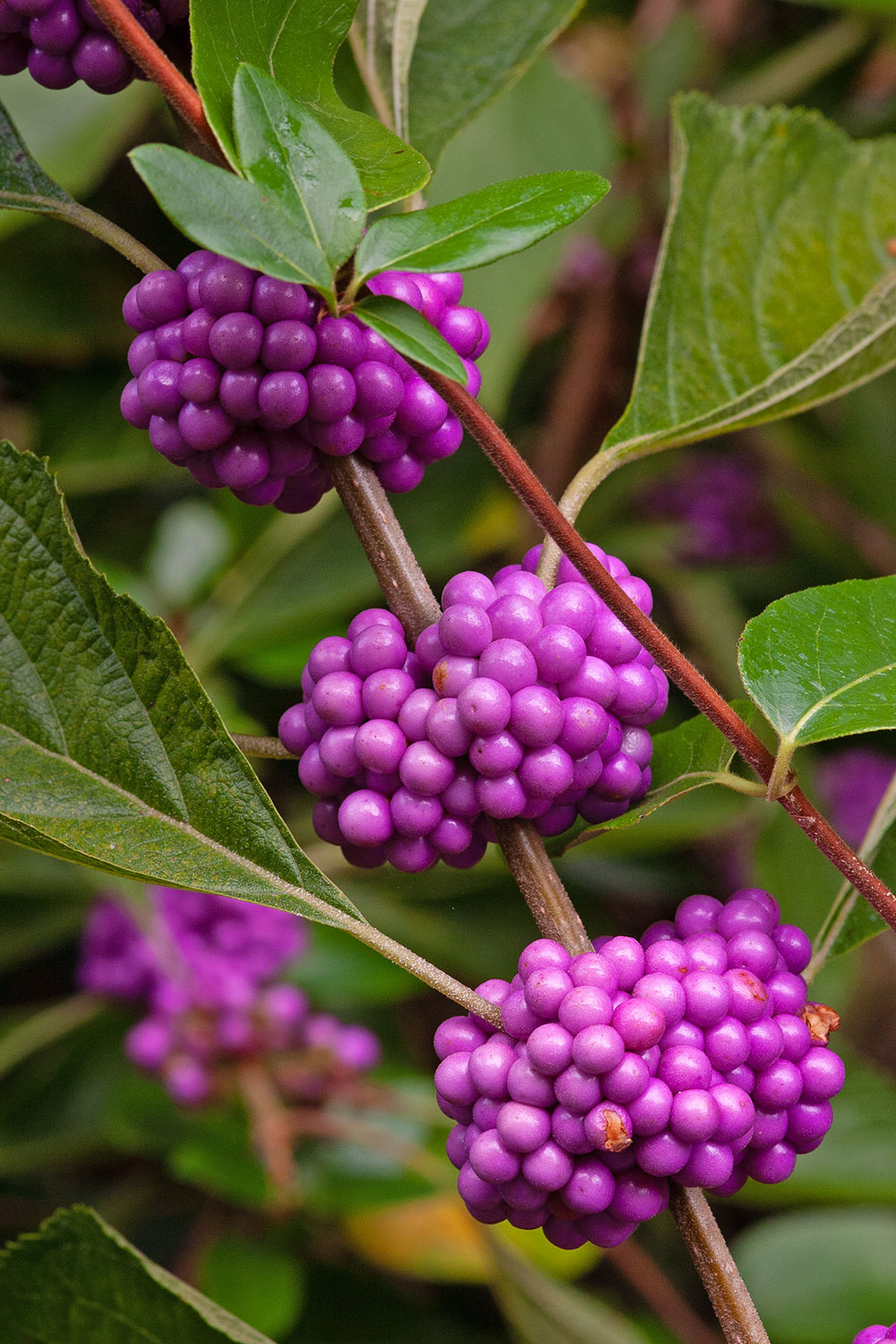If you planted beautyberries (Callicarpa sp.) in your landscape in the last year or two, you probably now feel like a smart gardener. Why? Because, just as many summer flower shows start to fade, the berries of this deciduous bush are beginning to show their true bright colors, which helps to extend visual razzle-dazzle in your landscape well into the fall.

Bring bright white into your garden with ‘Lactea.’
SEPTEMBER: For many adventurous gardeners, the beautyberry’s shiny fruits are Garden-of-Eden-like tempting — so, are they edible? Birds will eat them, but these long-lasting berries don’t seem to be one of their favorite fall and winter snacks. For gardeners, well, it depends on your definition of “edible.” Right off the branch, their taste ranges from bland to astringent, bordering on unpleasant. All is not lost for curious culinary creators because their flavor can be improved. An online search tagged “beautyberry jelly” will spill out bunches of recipes. And although not in the same abundance, instructions for making beautyberry wine can even be e-found.
OCTOBER: This year, were your hollyhocks’ leaves besmirched (yes, i said besmirched) with yellow or brown patches dotted by orange spots? The culprit was rust, a common fungal problem with hollyhocks. Fungicides applied during the growing season will help control this disease, but since it can overwinter in the plants, break up the life cycle of rust-causing spores by cutting back your hollyhocks to the ground now, bagging up the debris, and giving it a one-way ticket to the dump. In addition, this easy, effective cultural practice works well against botrytis blight, which can also afflict pretty hollyhocks with a bad case of the uglies.
Snazzy purple has long been the typical tint of beautyberries — so much so that many gardeners have been lulled into thinking that it is the only color of this shrub’s fruit. However, there are alt-purple selections sporting new hues that make this easy-to-grow pretty even more versatile in a landscape setting.
For starters, ‘Welch’s Pink’ displays a calmer coloration of lavender-pink berries that visually soothes rather than sizzles. It typically restrains itself to about 5 to 6 feet tall and wide. But, just like other beautyberries, ‘Welch’s Pink’ can also be kept in bounds with an annual pruning in late winter after its persistent berries have dried up — or been gobbled down by hungry birds.
Gardeners looking for berries with even less color but more twinkle will be pleased to know that, yes, there are white-fruited selections available. ‘Lactea’ is one of the best known (meaning easiest to find) and for good reason: it has long-lasting, pleasing bracelets of white berries that settle softly into a garden like autumn snowflakes. And ‘Lactea’ has friendly competition because the pale presentations of ‘Snow Star’ and ‘Albifructus’ have a similar look.
The white berries of ‘Duet’ put on a more modest show, only lightly dusting the limbs of this 4-foot-tall and wide shrub. But it takes two to make a duet harmonious, and in the case, the sprite-like berries are complemented nicely with variegated leaves that have margins generously splashed with shades of hazy cream, creating an eyecatcher in the garden from early spring until the fall fade.
I have seen “Welch’s Pink’ for sale even at big box home and garden centers, while the ‘Lactea’ and ‘Duet’ that grace my fall landscape are Raleigh Farmers Market finds. However, check with your friendly local garden shops, and if they don’t have any of these selections on hand, ask if they can order them for you. If that doesn’t work, it is easy to e-shop online for these “alt-purple beautyberries.”

‘Welch’s Pink’ is an alt-purple beautyberry

The visual harmony of ‘Duet’
To Do in the Garden
September
- This month can be a busy time in the ol’ veggie patch because turnips, radishes, spinach, parsnips, onions (bulbs), mustard greens, lettuce, collards, cauliflower, Swiss chard, carrots, broccoli, and cabbage can all be planted now.
- And if you enjoy fresh herbal helpers, there is still time to add arugula, cilantro, dill, and parsley to this year’s garden.
- Don’t encourage new growth on perennials and woody ornamentals because there probably won’t be enough time to harden off fresh shoots before the first frosts bite. In other words, save any high-nitrogen fertilizer flings for late next winter into the springtime.
- Many lawn and garden centers now want to move out garden equipment to make room for holiday merchandise, so watch for sales on trimmers, mowers, tillers, and other such outdoor handyman gear.
October
- Although planting season in the veggie patch is winding down, if your green thumb still has an itch, give it a scratch at the beginning of this month, when you still have time to slip in more spinach, onions (bulbs), garlic (bulbs), and Chinese cabbage.
- If you plan to use a pumpkin as a snappy seasonal decoration, remember it will keep better if not located in bright sunlight most of the day and left with a few inches of its stem attached. Also, an uncarved pumpkin will have a longer show-off life.
- Get into the spirit of Halloween and “haunt” local nurseries for end-of-growing-season sales on leftover perennials and woody ornamentals.
- Herbaceous perennials are long-lasting plants that die back or are cut down after the first frosts bite. They are also plants that you might forget where they are next spring unless you put markers beside them now before their late autumn disappearing act.
- Out & About in Wake County: September / October 2023
- The Rise of Live, Work, Play
- Something Worth Reading
- Small Business Spotlight: The ZEN Succulent
- Garden Adventurer: Beyond Purple: The Other Beautyberries
- Unleashing Comfort
- The Pet Parade 2023
- Less is More
- Erica Chats: Finally Feeling Fall
- Pay It Forward: SAFEchild
- Hummingbird
- Celebrated Spirits: Easy Peasy, Lemon Squeezy
- Celebrated Spirits: Unicycle Pale Ale









The beautiberry also make a beautiful and tasty jelly.
Could you explain the difference between the native and non-native varieties?
Thank you